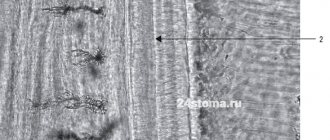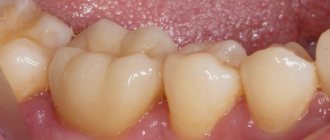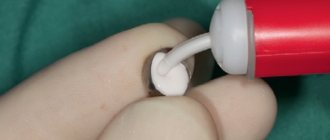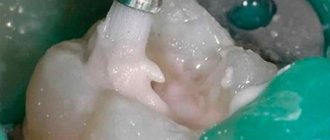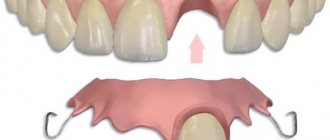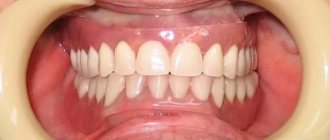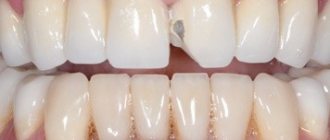Published 06/11/2020
The information in this article is provided for educational purposes and cannot be used for self-diagnosis, self-treatment and does not replace consultation with a doctor.
Dental cement is used to fill or make dental prosthetics. There are several types of it, most often used in dental practice, however, the type of fixation is divided into permanent and temporary.
Temporary cement: how does it work and when is the best time to use it?
In prosthetics, temporary cement is usually used when installing temporary and permanent crowns, as well as in cases where it is necessary to test the shade and functionality of the prosthetic structure.
Another issue is meeting deadlines: the dentist usually tells you how long to come for an appointment to remove the temporary crown and replace it with a permanent one. This means that the quality of the cement is designed to last for a certain period (temporary structures are designed to last several months). Accordingly, temporary cement has its drawbacks: displacement, loosening or complete decementation of the crown, inflammation of the gums, difficulties in cleaning the interdental spaces with dental floss.
Dental cement
Today in dentistry, “cement” is used not only for fillings, but also for prosthetics. This is a homogeneous and flexible mass that is obtained from powder and liquid. The latter hardens as a result of a chemical reaction.
Most often, dental cement is used for:
- Filling crowns;
- Filling dental crowns;
- Creation and fixation of fillings on the crown;
- When using fixed prosthetics.
Cement is used in most cases in pediatric dentistry. This is explained by the specific structure of baby teeth. Another direction where the mixture is used is the installation of fillings in adults. But since it begins to crumble fairly quickly, it is not used for permanent filling.
On this page you can find out detailed information about the methods and features of dental fillings in our clinic.
And here you can learn in detail about the indications for use and methods of installing a dental pin.
Such a material must have the following properties:
- biocompatibility , that is, it should not be rejected by living tissues;
- correct curing time , if the material hardens too early, it may not harden correctly and the procedure will have to be redone, the same can happen if hardening takes too long;
- hypoallergenic , the material should not cause an allergic reaction;
- strength , it will allow the material not to fall apart under chewing load on the tooth;
- aesthetics , especially important when using cement on the front teeth;
- homogeneous structure allows it to be evenly distributed throughout the dental canals;
- resistance to staining , such material should not be stained when eaten.
The fixation of metal-ceramic crowns can be divided into two groups: permanent and temporary. Ceramics are fixed with cement when the crown is installed for a short period of time and after a while it will need to be removed for subsequent treatment. As for long-term fastening, adhesives are used in this case.
Dental cement is distinguished by its flexibility at the setting stage and durability after hardening. There is a large range of mixtures of different shades for orthopedics and pediatric dentistry.
Based on the composition of the mixture, they are divided into
- phosphate (zinc and phosphoric acid);
- silicate (aluminum, phosphoric acid);
- glass ionomer (glass, polyacrylic acid).
Permanent or temporary cement?
In root canal treatment, temporary cement also has its place - even when a permanent crown is ready, the therapist may need access to the root canals, which means it is better to install a permanent crown with temporary cement. Otherwise, if root canal access is needed and the permanent crown has been placed with permanent cement, the therapist will need to make a hole in the crown to access the canals. In this case, there is a risk of cracks forming, which could cause crown breakage in the future.
A logical question arises: “Why not fix all crowns with temporary cement?” The answer is simple: an experienced dentist, after carrying out the necessary treatment, can confidently place a permanent crown on permanent cement, because he knows that the root canals have been treated efficiently and will not require opening the crown. If tooth extraction was recommended, but the patient insisted on canal treatment and there is no guarantee for such treatment, then a crown with temporary cement is installed.
Moreover, permanent cement ensures that the crown is tightly fixed to the tooth so that saliva and bacteria do not get under the crown.
Another point is the peace of mind and confidence of the patient: with permanent cement, he will not need to come to the dental clinic every few months, except for a general preventive examination.
Structure, types of cement
Cementum is represented by cells and intercellular substance. The cells are cementocytes, cementoclasts and cementoblasts.
Histologically, there are 2 types of cement: acellular and cellular.
Acellular cement, or primary cement as it is called, does not contain cells - only calcified intercellular substance. Its thickness is 23-40 microns. Covers the neck of the tooth.
Secondary cement (or cellular) covers the root with a small layer, located below the neck of the tooth. Cementocytes, process cells, are found in large numbers in the interroot sections and in the area of the apical part of the root. Cemetoblasts are also isolated, which are located on the surface of the cement. Cementocytes are localized in the thickness of the cementum of the tooth. Secondary cement is localized on acellular or dentin.
Compared to the primary, the secondary is formed much faster. Cementocytes are characterized by many branching processes and the presence of a large nucleus. When they die, they leave gaps in deeper layers. Closer to the periphery, cementoblasts are similar to cementoblasts and are more “active”. The latter contribute to the deposition of cement.
The intercellular substance is represented by collagen fibers, which, depending on their location, are divided into several types:
- growing into dentin;
- extending into the periodontium;
- localized within the cement, internal;
- growing into the periosteum of the alveoli.
The intercellular substance is also represented by mineralized glycosaminoglycans and matrix. Intercellular fibers are formed by their own cells (that is, cementum cells) and run parallel to the root. The fibers of the periodontal ligament, which are also part of the alveolar bone, pass at right angles to the tooth.
Functions of cement
As noted above, cementoblasts are functional cells, and it is thanks to them that subsequent layers of cement are deposited. Layers of tissue are deposited throughout a person’s life, and over a lifetime the thickness increases by 2-3 times. The deposition of cement is necessary to maintain the normal length of the tooth during the process of natural wear, and “pushing out” of the tooth occurs. This compensatory function, which is necessary to maintain the normal dimensions of the clinical crown through tissue layering, is called passive tooth eruption. In some cases, the layering may intensify at the apex of the tooth roots with the loss of the “opposite” tooth on the opposite dental arch.
Dental cement is necessary for attachment of peripheral periodontal fibers to the neck of the tooth and the root.
Unitem white (50g+30ml), VladMiVa
Cement for fixing pins, crowns, bridges and inlays. Unitem has high mechanical strength and chemical resistance.
- Description
- Shipping and payment
- Reviews
Description
Unicem is a universal zinc phosphate cement formed by mixing zinc oxide powder and phosphoric acid solution.
Indications
- Fixation of crowns, bridges, pins, inlays.
- Filling teeth that are to be covered with a crown.
- Can be used as an insulating gasket when filling with silicate and silica-phosphate cements, as well as amalgams.
Characteristics
- Powder: 50 g.
- Bottle of liquid: 30 ml.
- Powder measuring cup: 1 pc.
- Dropper cap: 1 pc.
Compound
- Zinc oxide powder with modifying additives.
- Orthophosphoric acid of reduced activity.
Cement mixing process
Advantages
- High mechanical strength (90-120 MPa, depending on the ratio of powder and liquid).
- High adhesion to metal, plastic, porcelain, metal ceramics and other dental materials.
- Cement is resistant to the aggressive action of the moist environment of the oral cavity.
Instructions for use
- If the material has been stored or transported at low temperatures, it should be kept at room temperature for one hour before use.
- On a dry glass plate, gradually mix the powder and liquid in the required proportion.
- The mixing time should not exceed 1 minute.
- Apply cement to the previously treated and dried tooth surface.
- The hardening time of the cement is 2 hours; during this period it is recommended to cover the filling with varnish or hydrophobic gel to protect it from the action of saliva.
Fixation of prostheses
- 1 scoop of powder (0.25-0.30 g) + 4 drops of liquid (0.18-0.20 g).
- The dough remains plastic on glass for 2-2.5 minutes, and hardens in the oral cavity within 8 minutes.
Dental filling
- 1 scoop of powder (0.25-0.30 g) + 3 drops of liquid (0.13-0.15 g).
- The dough remains plastic on glass for 1-1.5 minutes, and hardens in the oral cavity within 6 minutes.
Storage
- Store in a dry place, protected from direct sunlight, in a tightly closed container.
- Storage temperature: from +5°C to +25°C.
- Avoid exposure to moisture.
- Shelf life: 5 years.
The Nika Dent company is the official distributor of VladMiV products. We supply dental materials and consumables throughout Russia.
Shipping and payment
PAYMENT METHODS
| Cash to the courier upon receipt of the goods. Possible: in Moscow, Moscow region, St. Petersburg, Leningrad region. |
| By bank transfer for legal entities by account. |
TRANSFERING THE ORDER TO THE DELIVERY SERVICE
For cash payments:
the next day after receiving the order, unless a different delivery date has been agreed upon.
For non-cash payments:
the next day after receiving the money to the bank account.
Please check with your manager about the possibility of same-day delivery.
DELIVERY METHODS
Delivery by our transport is carried out in Moscow, Moscow region, St. Petersburg and Leningrad region.
To all other regions, delivery is carried out by transport companies.
Pickup of goods from the warehouse and company office is not provided.
COST OF DELIVERY
| Within the Moscow Ring Road: when ordering over 3,000 rubles - free. Up to 3,000 rubles – we temporarily do not deliver. |
| IN ST. PETERSBURG : when ordering over 3,000 rubles - free. Up to 3,000 rubles – delivery cost 350 rubles. |
| IN THE MOSCOW REGION: up to 50 km from the Moscow Ring Road: for orders over 5,000 rubles - free. Up to 5000 rubles – we temporarily do not deliver. 50-100 km from the Moscow Ring Road: for orders over 30,000 rubles - free. Up to 30,000 rubles – we temporarily do not deliver. |
| IN THE LENINGRAD REGION: up to 20 km from the Ring Road: for orders over 5,000 rubles - free. In all other cases - individually |
| TO OTHER REGIONS The minimum order amount to the regions is 3,000 rubles. Delivery is carried out by a transport company. The cost of delivery to the Moscow base of the transport company is free. Payment for the services of the transport company is at the expense of the client. We work with any Transport companies convenient for you! |
Repeated delivery due to the buyer's fault will be paid in any case!
Reviews
There are no reviews for this product yet. Be the first to leave a review!
